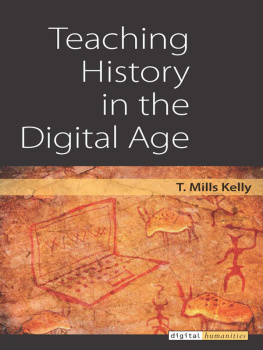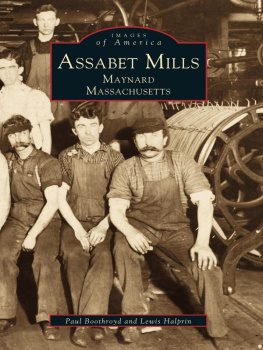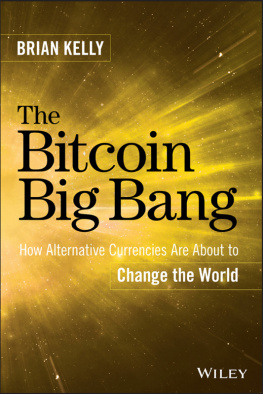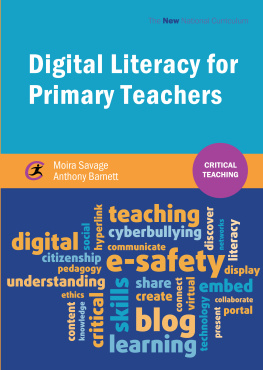T. Mills Kelly - Teaching History in the Digital Age
Here you can read online T. Mills Kelly - Teaching History in the Digital Age full text of the book (entire story) in english for free. Download pdf and epub, get meaning, cover and reviews about this ebook. year: 2018, publisher: The University of Michigan Press, genre: Religion. Description of the work, (preface) as well as reviews are available. Best literature library LitArk.com created for fans of good reading and offers a wide selection of genres:
Romance novel
Science fiction
Adventure
Detective
Science
History
Home and family
Prose
Art
Politics
Computer
Non-fiction
Religion
Business
Children
Humor
Choose a favorite category and find really read worthwhile books. Enjoy immersion in the world of imagination, feel the emotions of the characters or learn something new for yourself, make an fascinating discovery.
- Book:Teaching History in the Digital Age
- Author:
- Publisher:The University of Michigan Press
- Genre:
- Year:2018
- Rating:4 / 5
- Favourites:Add to favourites
- Your mark:
- 80
- 1
- 2
- 3
- 4
- 5
Teaching History in the Digital Age: summary, description and annotation
We offer to read an annotation, description, summary or preface (depends on what the author of the book "Teaching History in the Digital Age" wrote himself). If you haven't found the necessary information about the book — write in the comments, we will try to find it.
Teaching History in the Digital Age — read online for free the complete book (whole text) full work
Below is the text of the book, divided by pages. System saving the place of the last page read, allows you to conveniently read the book "Teaching History in the Digital Age" online for free, without having to search again every time where you left off. Put a bookmark, and you can go to the page where you finished reading at any time.
Font size:
Interval:
Bookmark:
 Page i Page ii
Page i Page ii The Digital Humanities series provides a forum for groundbreaking and benchmark work in digital humanities, lying at the intersections of computers and the disciplines of arts and humanities, library and information science, media and communications studies, and cultural studies.
Series Editors:
Julie Thompson Klein, Wayne State University
Tara McPherson, University of Southern California
Paul Conway, University of Michigan

Teaching History in the Digital Age
T. Mills Kelly
DIGITALCULTUREBOOKS, an imprint of the University of Michigan Press, is dedicated to publishing work in new media studies and the emerging field of digital humanities.
Page iiiTeaching History in the Digital Age
< T. Mills Kelly >
The University of Michigan Press
Ann Arbor
Page ivCopyright by T. Mills Kelly 2013
Some rights reserved

This work is licensed under the Creative Commons Attribution-Noncommercial-No Derivative Works 3.0 United States License. To view a copy of this license, visit http://creativecommons.org/licenses/by-nc-nd/3.0/ or send a letter to Creative Commons, 171 Second Street, Suite 300, San Francisco, California, 94105, USA.
Published in the United States of America by
The University of Michigan Press
Manufactured in the United States of America
 Printed on acid-free paper
Printed on acid-free paper
2016 2015 2014 2013 4 3 2 1
A CIP catalog record for this book is available from the British Library.
http://dx.doi.org/10.3998/dh.12146032.0001.001
Library of Congress Cataloging-in-Publication Data
Kelly, T. Mills.
Teaching history in the digital age / T. Mills Kelly.
pages cm. (Digital humanities)
Includes bibliographical references.
ISBN 978-0-472-11878-6 (hardback) ISBN 978-0-472-02913-6 (e-book)
1. HistoryComputer-assisted instruction. 2. HistoryStudy and teaching (Higher)Technological innovations. I. Title.
D16.255.C65K45 2013
907.8'5dc23
2012047396
Page vHistorians are always a little nervous about the whole concept of beginnings, because we know just how difficult it is to pin down, exactly, when something began. In the case of this book, though, it is not difficult for me to say exactly when it began. During the 19961997 academic year I was a visiting instructor in the Department of History at the University of New Hampshire. About a month into the fall semester, we all received a memo (not an email) from the campus IT staff asking Do you want to learn how to put your syllabus on the World Wide Web? I wish I had saved that memo, because it launched me down the path that led to this book.
I signed up for that workshop and over the course of two hours or so, learned enough basic HTML code to put my syllabus on the university's servers. That was in the days before even Netscape Composer, much less Dreamweaver, or any other website-building software, so we had to write our own code. I promptly put my syllabus up online and in class the next day told all my students they could now access their class syllabus on the Web (as we called it in those days). Because only about half of them had email addresses, I had to tell them in person. My nave belief was that with the syllabus online 24/7, never again would a student be able to say to me, Oh, Dr. Kelly, I didn't do the reading for today, because I couldn't find my syllabus. The online syllabus did eliminate that excuse, but, of course, they found others that were equally compellingat least in their eyes. But that does not mean they did not work hard and try to learn what I was teaching them; it is just that technology did not change every dynamic of the college classrooman important lesson we would do well to remember. That online syllabus did have a surprising result. When I Page vi got my end-of-semester survey results back, student after student wrote in their comments that the online syllabus was one of the best parts of the coursenot my carefully crafted lectures, or those group learning exercises I spent so much time planning. On the one hand, I was disappointed that all the work I had done to create an exciting learning experience seemed to have had little impact. On the other, I was glad to have found something that sparked their interest.
Between the fall and spring semester that year I received a call from the director of the University of New Hampshire-Manchester campus who wanted to know if I could fill in at the last minute for one of their history faculty members who, for medical reasons, could not teach the first half of Western Civilization in the spring semester. I needed the money (our first child had been born just a few weeks earlier) and so I agreed, even though I had never taken a class in European history prior to 1600. When I informed the person offering me the job of this, he said something along the lines of, That's okay, you'll know more about it than they do. Now that I direct a program at my university I know that sometimes we have to make such last-minute compromises to avoid canceling classes, but at the time, I was both thankful for the work and a little uncomfortable with the ethics of teaching a subject I was weak on. With a fair amount of trepidation, I designed a course, largely around the textbook, but included my first Internet-based assignment. I introduced my students to this new thing called the Internet (maybe I said World Wide Web), and explained that one could find many historical primary sources online using the Lynx web browser the university made available to us. These were all text-only sourceswhite text on a black screen. I wanted them to each find a source every week, print it out, bring it in, and we would talk about it. In this way, my students built a miniature library of primary sources for the class and I was saved from having to look up lots of sources on my own to supplement those in the document reader I had assigned. To my surprise and pleasure, our discussions of the sources my students found, as opposed to the ones I assigned, were the most interesting and generative conversations of the semester. That lessonthat students can take a very important role in their own learningis another we would be wise to remember. Once again, at the end of the semester I heard from my students that the Internet assignment was the best part of the course. I was smart enough to realize I was onto something.
The following year, I was a sabbatical replacement instructor at Grinnell Page vii College. While there, I built my first website and began to post resources online. I also designed several additional assignments that made use of resources others had posted online. In my second semester I even had my students build a website of their owna small archive of primary sources. It was an assignment they enjoyed, but also found frustrating due to their low technical skills and the relatively high bar for entry into the world of creating online content in 1998. At some point in the spring semester, my department chair (the great Russian historian Dan Kaiser) asked me a very important question. Given the amount of time all that Internet stuff was takinghe did not say it was taking time from my traditional scholarship, but we both knew it washow did I know that my students were learning better, or at least differently by working with online historical resources? I had no earthly idea. I knew they were enjoying what they were doing with the technology, and I think we can all agree that if students are engaged, something positive is probably happening. But I really did not know if they were learning better or worse.
Next pageFont size:
Interval:
Bookmark:
Similar books «Teaching History in the Digital Age»
Look at similar books to Teaching History in the Digital Age. We have selected literature similar in name and meaning in the hope of providing readers with more options to find new, interesting, not yet read works.
Discussion, reviews of the book Teaching History in the Digital Age and just readers' own opinions. Leave your comments, write what you think about the work, its meaning or the main characters. Specify what exactly you liked and what you didn't like, and why you think so.








![Brian Kelly [Brian Kelly] - The Bitcoin Big Bang: How Alternative Currencies Are About to Change the World](/uploads/posts/book/119681/thumbs/brian-kelly-brian-kelly-the-bitcoin-big-bang.jpg)

